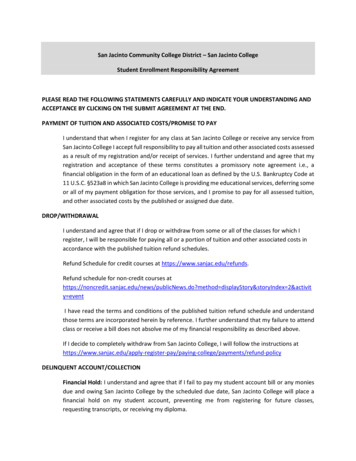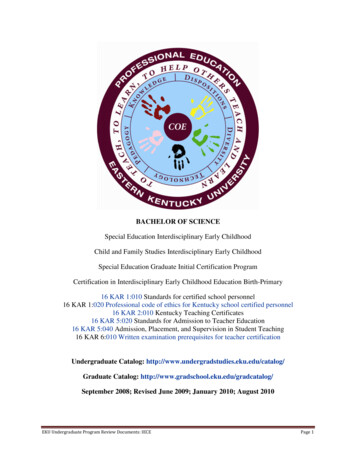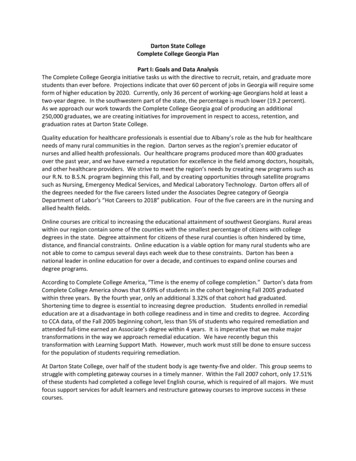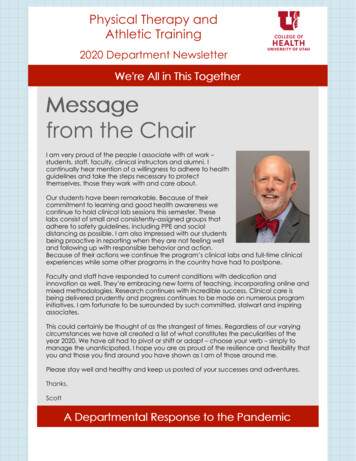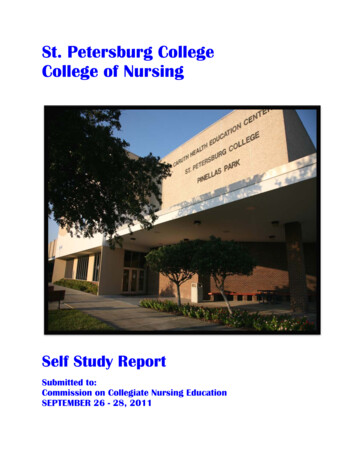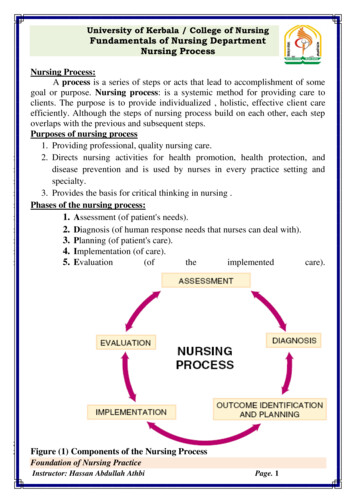
Transcription
University of Kerbala / College of NursingFundamentals of Nursing DepartmentNursing Process119Nursing Process:A process is a series of steps or acts that lead to accomplishment of somegoal or purpose. Nursing process: is a systemic method for providing care toclients. The purpose is to provide individualized , holistic, effective client careefficiently. Although the steps of nursing process build on each other, each stepoverlaps with the previous and subsequent steps.Purposes of nursing process1. Providing professional, quality nursing care.2. Directs nursing activities for health promotion, health protection, anddisease prevention and is used by nurses in every practice setting andspecialty.3. Provides the basis for critical thinking in nursing .Phases of the nursing process:1. Assessment (of patient's needs).2. Diagnosis (of human response needs that nurses can deal with).3. Planning (of patient's care).4. Implementation (of care).5. Evaluation(oftheimplementedcare).2021Figure (1) Components of the Nursing Process23456789101112131415161718Foundation of Nursing PracticeInstructor: Hassan Abdullah AthbiPage. 1
University of Kerbala / College of 272829303132333435363738Fundamentals of Nursing DepartmentNursing ProcessSteps (Phases) of nursing process:1. Assessment:Is the first step in the nursing process and includes systemic collection,verification, organization, interpretation (analysis), and documentation of data.The completeness and correctness of the information obtained during assessmentare directly related to the accuracy of the steps that follow. Assessment involvesseveral steps:a. Data collection from a variety of sources.b. Data validation.c. Organizing the data.d. Data interpretation (Data analysis).e. Making initial inferences or impressions.f. Recording or reporting data.Purpose of assessment:1. Organize a database regarding a client physical, psychological, andemotional health.2. Identified of health promoting behaviors and actual or potential healthproblems.3. The nurse can ascertains of the clients about:a. Functional abilities,b. Absence or the presence of dysfunction,c. Normal activities of daily living, andd. Lifestyle pattern.4. Identifying the client strengths gives the nurse information about theabilities, behavior, and skills the client can use during the treatment andrecovery process.5. Provides an opportunity to form a therapeutic interpersonal relationshipwith clients.6. The client can discuss health care concerns and goals with the nurse.Type of assessment:The information needed for assessment is usually determined by healthcare setting and needs of the clients. Three types of assessment includes:1. Comprehensive assessment:a. Provide baseline of client data including a complete health history andcurrent needs assessment.b. Usually completed upon admission to health care agency.c. Changes in the clients health status can be measured against thisdatabase.Foundation of Nursing PracticeInstructor: Hassan Abdullah AthbiPage. 2
University of Kerbala / College of 272829303132333435363738Fundamentals of Nursing DepartmentNursing Processd. Includes of clients physical and psychological health, perception ofhealth, presence of health risk factors, and coping patterns.2. Focused assessment:a. Is limited to potential health care risks, a particular need, or health careconcern.b. There are not as a detailed as comprehensive assessment.c. Often used when short stays are anticipated (e.g., outpatient surgery andemergency departments).d. Used in specialty areas such as mental health settings and delivery.e. Used in screening for specific problems or risk factors.3. Ongoing assessment:a. Follow up , or monitoring of specific problems.b. Broadens the database and allow the nurse to confirm the validity of dataobtained during the initial assessment.c. Systematic monitoring allows the nurse to determine the clients responseto nursing interventions and to identify any other problems.Sources of Data collection by assessment methods:A. Primary sources: the client should be considered the primary source ofdata. As much information as possible should be gathered from the client,using both interview techniques and physical examination skills.B. Secondary sources: data source from other than the client are consideredsecondary sources (family members, other health care providers, andmedical records).Types of Data collection by assessment methods:A. Subjective data (also called symptoms):are data from the client’s point of view (provided verbally by thepatient) and include feelings, perceptions, and concerns. Interview is theprimarily method of collecting subjective information. Steps of collectingsubjective data:1. Begin with the patient’s main concern (chief complain ).2. Reason of seeking health care. The question, “What happened that madeyou decide to come to the hospital (clinic, office)?”3. Use the letters of the “WHAT’S UP?” questioning format to rememberquestions to ask the patient, See table (1) Guide to SymptomAssessment4. Obtain a patient history by asking the patient and family questions aboutpatient’s past and present health problems, including specific questionsabout each body system, family health problems, and risk factors forFoundation of Nursing PracticeInstructor: Hassan Abdullah AthbiPage. 3
University of Kerbala / College of entals of Nursing DepartmentNursing Processhealth problems. The patient’s medical record may also be consulted forbackground history information.Examples of subjective information :a. I have had pains in my legs for three days ago.b. I have had headache, nausea, vomiting, dizziness for three hours ago.c. I have had anxiety from surgery.WHAT’S UP? Guide to Symptom AssessmentW—Where is it?H—How does it feel? Describe the quality.A—Aggravating and alleviating factors. What makes it worse? What makes itbetter?T—Timing. When did it start? How long does it last?S—Severity. How bad is it? This can often be rated on a scale of 0 to 10.U—Useful other data. What other symptoms are present that might be related?P—Patient’s perception of the problem. The patient often has an idea about whatthe problem is, or the cause, but may not believe that his or her thoughts areworth sharing unless specifically asked.Table (1) Guide to Symptom AssessmentB. Objective data (also called signs): are observable and measurable datathat are obtained through both physical examination and the result oflaboratory and diagnostic tests. The primary method of collecting objectiveinformation is the physical examination, which provides information aboutthe function of body systems. Inspection, palpation, percussion, andauscultation techniques are used to collect objective data.Examples of objective information include:a. Temperature (37.3 C), Pulse rate (100 b/m), Respiration (18 T/m),Blood pressure (130/76 mm/hg).b. Positive bowel sounds.c. Flushed face.Validating the data:Objective information may add to or validate subjective information.Validation is a critical step in data collection to avoid omissions, preventmisunderstandings, and avoid incorrect inferences and conclusions.Organizing the data:Foundation of Nursing PracticeInstructor: Hassan Abdullah AthbiPage. 4
University of Kerbala / College of 272829303132333435363738Fundamentals of Nursing DepartmentNursing ProcessData that are collected must be organized to be useful to the health careprofessional collecting the data as well as others involved with the client’s care.Data should be organize through:a. Data clustering (admission assessment format): is the process to puttingthe data together in order to identify areas of the client problems andstrengths.b. Assessment model: is a framework providing a systematic way to organizedata such as:1. Hierarchy of needs: proposes that an individual basic needs(physiological) must be meet before higher level can be meet.2. Body system model: organizes data according to tissue and organfunction in the various body systems.3. Functional health pattern: cluster information about client habitualpattern and any change to determine if the clients current response isfunctional or dysfunctional.4. Theory of self care: based on the client ability to meet self care needsand identifying existing self care deficits.Interpreting the data: when data are placed in clusters the nurse can :a. Distinguish between relevant and irrelevant data.b. Determine whether and where there are gaps in the data.c. Identify patterns of cause and effect.Documenting the data:Assessment data must be recorded and reported. The nurse must make ajudgment about which data are to be reported immediately and which dataneed only to be recorded at that time. Data that reflect a significant deviationfrom the normal (for example, rapid heart rate with irregular rhythm, severedifficulty in breathing, or high levels of anxiety) would need to be reported aswell as recorded. Examples of data that need only to be recorded at the timeinclude a report that prescribed medication has relieved a headache and adetermination that an abdominal dressing is dry and intact.NOTE: Assessment does not end with the initial interview and physicalexamination. Assessment is dynamic and continues with each nurse-clientinteraction.2. Nursing Diagnosis phase:Involves further analysis and synthesis of the data that have beencollected. According to the North American Nursing Diagnosis Association(NANDA) a nursing diagnosis: Is a clinical judgment about individual,family, or community responses to actual or potential health problems / lifeFoundation of Nursing PracticeInstructor: Hassan Abdullah AthbiPage. 5
University of Kerbala / College of amentals of Nursing DepartmentNursing Processprocesses. The nursing diagnoses provide the basis for client care deliveredthrough the remaining steps. Clients receive both medical and nursingdiagnoses(Table 2). A medical diagnosis : Is a clinical judgment by thephysician that identifies or determines a specific disease, condition, orpathological state.Medical DiagnosisNursing DiagnosisFocuses on illness, injury, or disease Focuses on clients responses to actual orprocess.potential health problems or life processes.Remains constant until a cure is Changes as the client’s response and/or theeffected or client dies.health problem changes.Recognizes conditions the physician Recognizes situations that the nurse isis licensed and qualified to treat.licensed and qualified to intervene.Example: (Lung cancer, Congestive Example: (Nausea, Acute pain, Anxiety,heartfailure,Braintumor, Impaired physical mobility, IneffectiveExploratorysurgery, breathing pattern, Risk for imbalanced fluidAppendectomy, Bronchial asthma). volume).Table (2) Comparison of Medical Diagnoses and Nursing DiagnosesTypes of Nursing Diagnoses:1. Actual nursing diagnosis (Actual problems):a. Indicates that a problem exists.b. Composed of (diagnostic label, related factors, and signs and symptoms).c. Example (Impaired Skin Integrity related to prolonged pressure on bonyprominence as manifested by stage II pressure ulcer over coccyx, 3 cmin diameter).2. Risk nursing diagnosis (Potential problems):a. Indicates that a problem does not yet exist, but special risk factors arepresent.b. A risk diagnosis is composed of the diagnostic label preceded by the phrase“risk for” with the specific risk factors listed.c. An example of a risk diagnosis is: (Risk for Impaired Skin Integrityrelated to inability to turn self from side to side in bed).d. A possible (Potential) nursing diagnosis indicates a situation in which aproblem could arise unless preventive action is taken.e. A possible diagnosis is composed of the diagnostic label and relatedfactors.Foundation of Nursing PracticeInstructor: Hassan Abdullah AthbiPage. 6
University of Kerbala / College of 272829303132333435363738Fundamentals of Nursing DepartmentNursing Processf. An example of a possible diagnosis is: (Possible Self-Esteem Disturbancerelated to recent retirement and relocation). The nurse may not yet haveenough data to confirm this diagnosis or a more specific one. However, thisdiagnosis will alert other nurses to collect data that will either confirm thisor another diagnosis, verify a risk diagnosis, or rule out the existence of aproblem.3. Wellness nursing diagnosis (Wellness conditions):a. Indicates the client’s expression of a desire to attain a higher level ofwellness in some area of function.b. Composed of the diagnostic label preceded by the phrase “potential forenhanced.”c. For example a client who is neither overweight nor underweight tells thenurse that she knows she could improve her diet in some ways. Sheexpresses a desire to know more about how to improve her diet. The nursewould make a wellness diagnosis of Potential for Enhanced Nutrition.4.Collaborative problems:Are defined as physiologic complications monitored by nurses to assesschanges in client status. Usually collaborative problems involve alterations inorgan and/or system function or structure (e.g., myocardial infarction, duodenalulcer). Collaborative problems begin with the label potential complicationfollowed by the situation. for example, respiratory are the specific collaborativeproblems of potential complication : hypoxemia.3.Outcome Identification and Planning phase:Includes the formulation of guidelines that establish the proposed course ofnursing action in the resolution of nursing diagnoses and the development of theclient’s plan of care.The planning of nursing care occurs in three phases:a. Initial planning: Developed by the nurse who performs the admissionassessment and gathers the comprehensive admission assessment data.b. Ongoing planning: Updating
Providing professional, quality nursing care. 10 2. Directs nursing activities for health promotion, health protection, and 11 . Appendectomy, Bronchial asthma). Example: (Nausea, Acute pain, Anxiety, Impaired physical mobility, Ineffective breathing pattern, Risk for imbalanced fluid volume). 6 Table (2) Comparison of Medical Diagnoses and Nursing Diagnoses 7 Types of Nursing Diagnoses: 8 1 .

